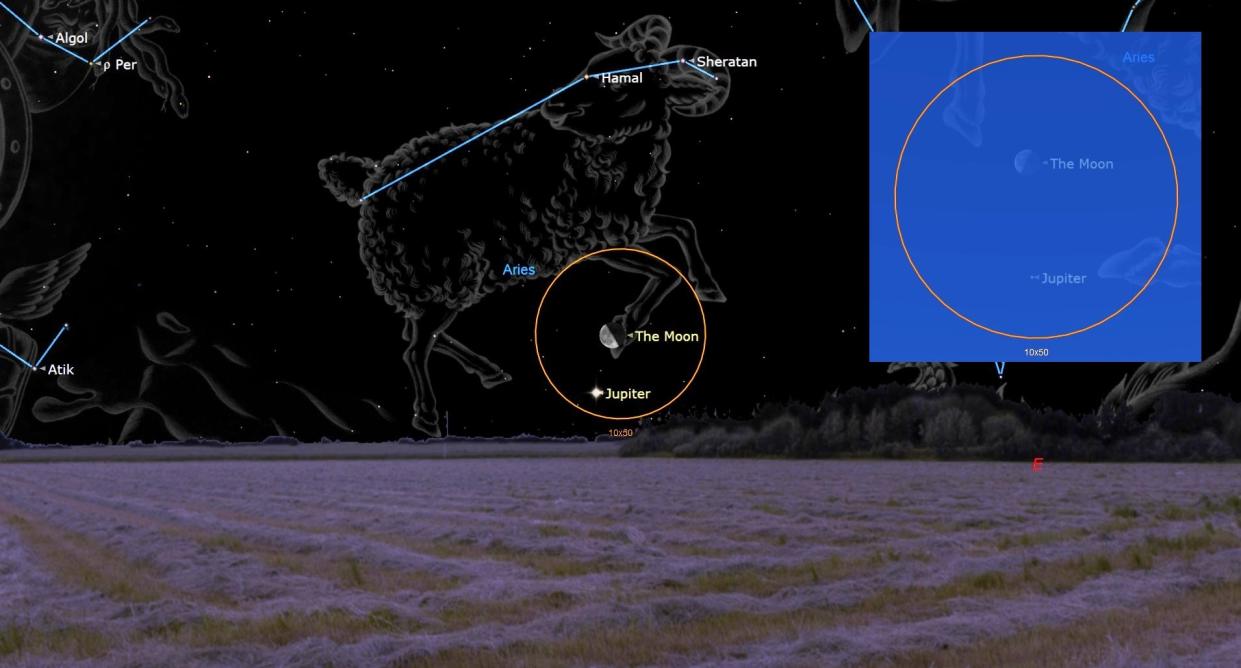See Jupiter and the half moon join up in the night sky tonight

At New York's Hayden Planetarium where I've spent the last 37 years serving in the role as an Associate and Guest Lecturer, lately we've been getting an increasing number of phone calls making basically the same inquiry. A typical call goes something like this: "I was out shortly after midnight last night and could not help but notice a brilliant silvery star glowing low in the east-northeast. It was far brighter than any star and I was just curious to know what I was looking at."
The object in question is the largest planet in our solar system: Jupiter. It's a welcome sight, rising in the late evening and coming up above the east-northeast horizon this week by 11:45 p.m. local daylight time.
And late tonight (Aug. 7) right on into the early morning hours of Tuesday (Aug. 8) Jupiter will have company, for hovering a little over 2 degrees above and a bit to its left will be the last quarter or "half" moon. Your clenched fist held at arm's length measures roughly 10 degrees; so, the moon will appear less than a quarter of a fist above Jupiter during the overnight hours of Monday/Tuesday).
Related: Night sky, Aug. 2023: What you can see tonight [maps]
TOP TELESCOPE PICK:

Want to see the four largest moons of Jupiter? We recommend the Celestron Astro Fi 102 as the top pick in our best beginner's telescope guide.
The king of the planets is currently positioned among the stars of Aries, the ram. Now that dazzling Venus is hidden between Earth and the sun, Jupiter is indeed the brightest "star" in the night sky, currently shining at -2.4 magnitude or more than 2 and a half times brighter than the brightest star, Sirius.
Put simply, you can't miss it.
And Jupiter will only continue to gain in brilliance in the coming weeks.
Jupiter will continue to rise earlier as Earth's motion around the sun carries us toward opposition with the giant planet in early November. At that point we will fly between Jupiter and the sun, and they will be on opposite sides of the sky. So, until then Jupiter will appear to brighten further, because the distance between us is steadily decreasing. Currently, the planet is 40.2 light-minutes from Earth, but this is destined to shrink to only 33.1 light minutes by mid-autumn.
Keep in mind that when you look at the moon relative to Jupiter, that our natural satellite is only about 1.26 light seconds from us — or more than 1,900 times closer than the more distant Jupiter.
Note too, that Jupiter is getting brighter and also looking great in telescopes now, though to see it at nearly its highest and steadiest this week, the best time to look is during morning twilight, about 60 to 90 minutes before sunrise.
If you have a small telescope or a good pair of binoculars that you can hold steady or mount on a tripod, you can also check out Jupiter's four big moons, first sighted in 1610 by Galileo. Jupiter will appear to be flanked by two moons on either side. On its eastern (left) side, you'll see (going outward from Jupiter), Io and Ganymede, while on the western (right) side, will be Europa and Callisto.
And I'm sure that should the sky be clear late Monday night that come next Tuesday I'm certain to take lots of inquiries from people wanting to know what that "UFO" was below the moon on Monday night and that seemed to follow it across the sky into the early hours of Tuesday morning.
At least you now know what that "UFO" is!
And remember: If you're looking for a telescope or binoculars to observe the moon, our guides for the best binoculars deals and the best telescope deals now can help. Our best cameras for astrophotography and best lenses for astrophotography can also help you prepare to capture the next skywatching sight on your own.
Joe Rao serves as an instructor and guest lecturer at New York's Hayden Planetarium. He writes about astronomy for Natural History magazine, the Farmers' Almanac and other publications.

